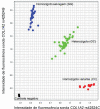Genetic Polymorphisms in COL1A2 gene and the Risk of Tendinopathy: Case-Control Study
- PMID: 37396081
- PMCID: PMC10310418
- DOI: 10.1055/s-0042-1757959
Genetic Polymorphisms in COL1A2 gene and the Risk of Tendinopathy: Case-Control Study
Abstract
Objective To evaluate the influence of polymorphisms on genes encoding type I collagen and the genetic susceptibility of tendinopathy. Methodology Case-control study involving 242 Brazilian athletes from different sports modalities (55 cases of tendinopathy and 187 controls). The polymorphisms COL1A1 (rs1107946) and COL1A2 (rs412777, rs42524, and rs2621215) were analyzed by the TaqMan system. Odds ratio (OR) with their 95% confidence intervals (CIs) were calculated using a nonconditional logistic regression model. Results The mean age was 24.0 ± 5.6 years old and 65.3% were men. Of the 55 cases of tendinopathy, 25.4% had > 1 affected tendon, the most frequent being patellar (56.3%), rotator cuff (30.9%) and elbow or hand flexors (30.9%). Age and amount of time of sports practice were associated with a higher chance of presenting tendinopathy (5 and 8 times, respectively). The frequency of variant alleles in control and case patients, respectively, was: COL1A1 rs1107946 24.0 and 29.6%; COL1A2 rs412777 36.1 and 27.8%; rs42524 17.5 and 25.9%; and rs2621215 21.3 and 27.8%. After adjusting for confounding factors (age and years of sports practice), COL1A2 rs42524 and rs2621215 polymorphisms were associated with increased risk of tendinopathy (OR = 5.5; 95%CI = 1.2-24.6 and OR = 3.9; IC95% = 1.1-13.5, respectively). The haplotype COL1A2 CGT was associated with low risk for disease development (OR = 0.5; 95%CI = 0.3-0.9). Conclusion Age (≥ 25 years old), time of sports practice (≥ 6 years) and polymorphisms in the COL1A2 gene increased the risk of developing tendinopathy.
Keywords: athletes; collagen type 1; polymorphism, genetic; tendinopathy.
Sociedade Brasileira de Ortopedia e Traumatologia. This is an open access article published by Thieme under the terms of the Creative Commons Attribution-NonDerivative-NonCommercial License, permitting copying and reproduction so long as the original work is given appropriate credit. Contents may not be used for commercial purposes, or adapted, remixed, transformed or built upon. ( https://creativecommons.org/licenses/by-nc-nd/4.0/ ).
Conflict of interest statement
Conflito de Interesses Os autores declaram não haver conflito de interesses.
Figures












References
LinkOut - more resources
Full Text Sources
Miscellaneous

